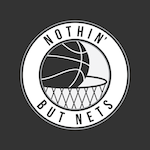
NEW YORK, NEW YORK - DECEMBER 13: Kevin Durant #7 of the Brooklyn Nets dribbles the ball during the second half against the Washington Wizards at Barclays Center on December 13, 2020 in the Brooklyn borough of New York City. NOTE TO USER: User expressly acknowledges and agrees that, by downloading and or using this photograph, User is consenting to the terms and conditions of the Getty Images License Agreement. (Photo by Sarah Stier/Getty Images)
Brooklyn Nets: What did we see from Kevin Durant in his debut?
Seeing Kevin Durant on the court for the Brooklyn Nets was a welcome sight, but there’s also what to take away from his first action in quite some time.
It took 552 days but Kevin Durant was finally able to make his long-anticipated Brooklyn Nets debut in a 119-114 preseason victory over the Washington Wizards.
KD played just under 24 minutes, none in the fourth quarter. He put up 15 points on 5-of-10 shooting on twos while missing both of his 3-point attempts. He earned six free throws and made five of them. Durant also chipped in three rebounds, three assists and two blocks while coughing up three turnovers and committing two fouls.
Before any sweeping declarations can be made about Brooklyn’s title hopes based on how Durant looked in his first action since June 2019, two caveats are necessary to acknowledge. This was just a preseason game, one that came against the league’s second-worst defense from a season ago without its two best players.
Whatever your feelings are from Durant’s Nets debut, it’s important to filter them through that lens and adjust your takeaways accordingly.
Maybe the most important long-term takeaway from this game wasn’t what Durant did but the position he was put in to do it. Steve Nash previously spoke about the desire to have his best player function within all five positions. The new head coach wound up starting the game with KD at power forward, a position the former two-time Finals MVP has never occupied full-time.
Considering the scarcity of wings in Brooklyn, the move allows the Nets to downsize and take advantage of all the multi-faceted talents at their disposal with Spencer Dinwiddie starting in the backcourt alongside Kyrie Irving. They were joined by Joe Harris’ floor spacing and DeAndre Jordan’s rim running.
Moving down matches Durant up with bigger forwards who can’t possibly stay in front. His first basket was the result of a hopeless closeout by Thomas Bryant, the closest defender following a scramble of a long rebound. No matter how unlikely such a scenario is moving forward — being lunged at on the catch by a center — there was a certain pleasantry in watching Durant easily blow by the young big via a rip through for the two-handed jam.
An Achilles tear typically robs athletes of their athleticism. Though not a particularly high flyer or explosive finisher, part of what has made Durant so dangerous is the change of pace he can pull on defenders with a guard’s handles packaged into his seven-foot frame.
His unlockable jumper would ensure that he could always get a shot off. Following such a devastating injury, the question pertained more to whether he could create the space and get to the spots that would constitute an efficient look.
Durant seemed to show no ill-effects moving side to side in the play below. Though he wound up missing a fairly makeable jumper, he looked like his old self by shifting gears as he did before pulling up just inside the right elbow.
KD has come a tremendous way as a passer, topped off with a career-high 5.9 assists per game during his final season in Golden State.
His passes will never make highlight reels. They’re simply the result of horizons expanded that even predate his days with the pass-happy Warriors. Durant is far more conscious of the open man as a result of the second defender he almost always draws on drives.
In this sequence, the help man is Troy Brown Jr., who steps in to cut off Durant after he rejected a Jordan screen with a straight line to the rim. Brown steps up. Timothe Luwawu-Cabarrot sneaks from the left corner towards the rim behind him. Durant hits him with a bounce pass. Deni Avdija is late to help and TLC gets an easy dunk.
More so than the individual talent of Durant and Irving, it’s these types of sequences that will ultimately define this Nets team. They have a plethora of players who work best with the ball in their hands with only so many touches to go around.
When those guys inevitably have to play off the ball, are they going to do a James Harden impersonation and glue their feet to one spot along the arc without ever giving defenses the impression they’ll move? Or will there be constant — maybe at least situational? — movement similar to the type Stephen Curry uses to generate open looks?
At 38.8 percent from three last year, Luwawu-Cabarrot shouldn’t even be stepping inside the 3-point line. But he saw the play developing towards an easy bucket and capitalized. Nash must foster more of this movement to make life easier for Durant and extract the most he can from a potentially potent offense.
It’s hard to imagine a world where Durant returns to the caliber of defender he was in Golden State. Not only is the Achilles tear a factor but Durant recently turned 32 in September. He’s still got plenty left in his tank but that doesn’t exactly put him on the younger side of NBA players.
Such concerns are what make his potential move to power forward full time so beneficial at the defensive end. Durant gives every type of opponent headaches on offense, but matching up with traditional wings would force him to guard much quicker players, further pressing a body in no need of more aggravation.
Even if Durant has lost a step, it’s one not needed against many of the power forwards of today. And for those who do manage to get a step ahead, as Rui Hachimaru did in the play below, KD’s 7’4” wingspan helps him recover ground and block the shot.
Durant still has a ways to go before the masses deem him worthy of the status he held before going down in the 2019 Finals. With games of higher stakes and better competition on their way, he’ll get his chance soon enough.
For now, it’s safe to say Durant has given us plenty to grow excited about after starving for his talents for well over a year, even laying out his body to draw a charge on Hachimura in the second quarter.
That is, until his next assessment which, should he choose to partake, would be in Boston on Friday.


